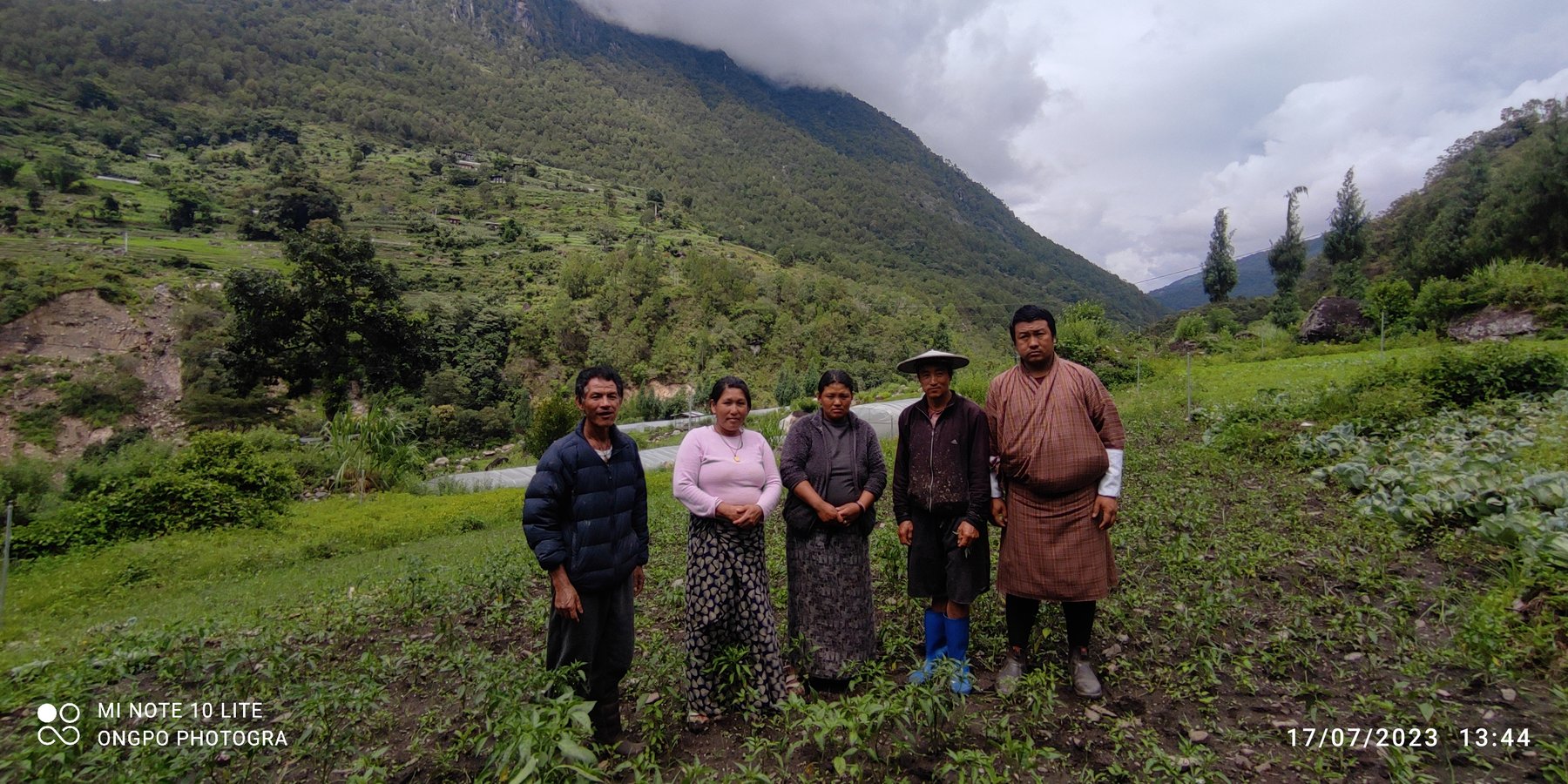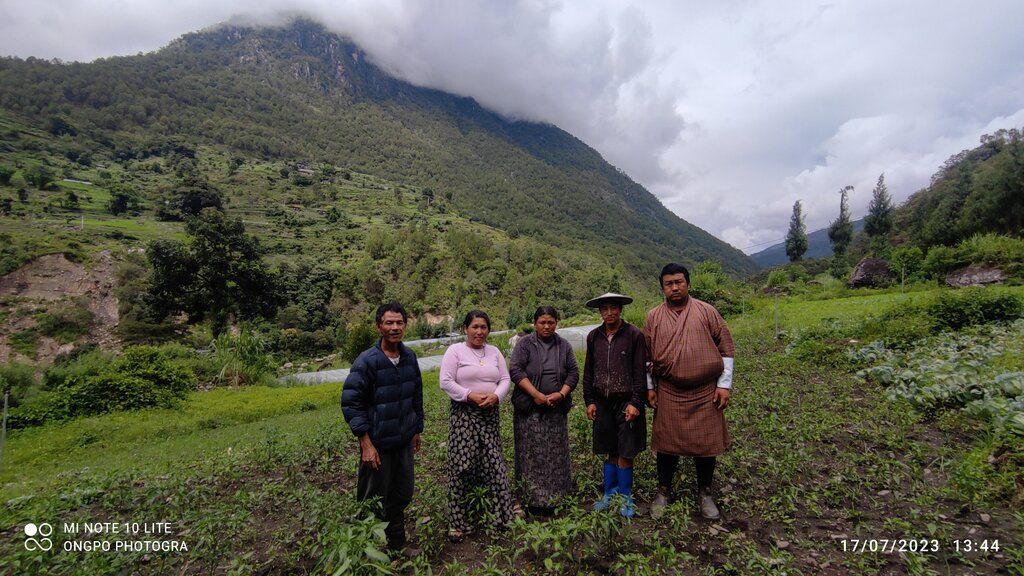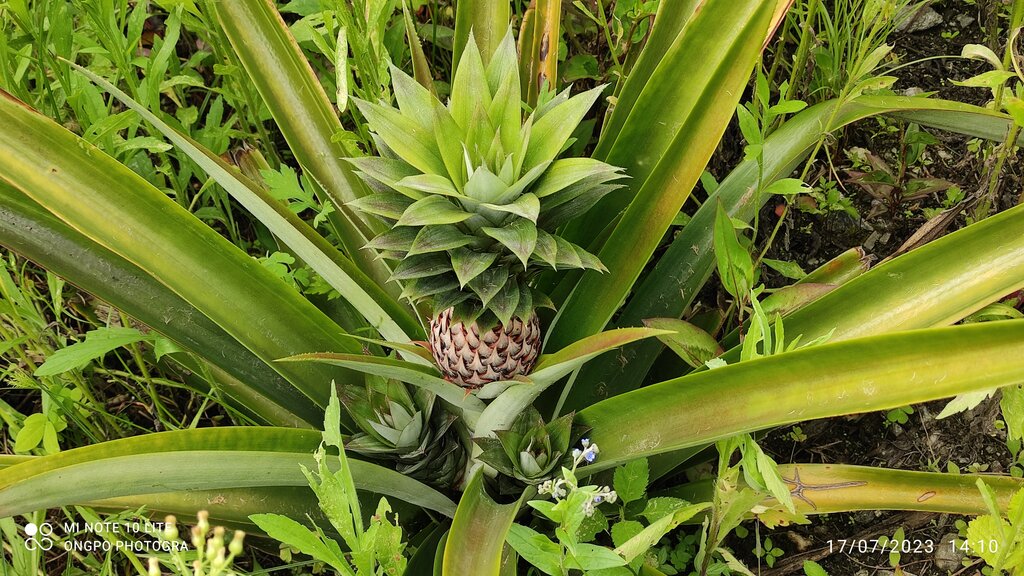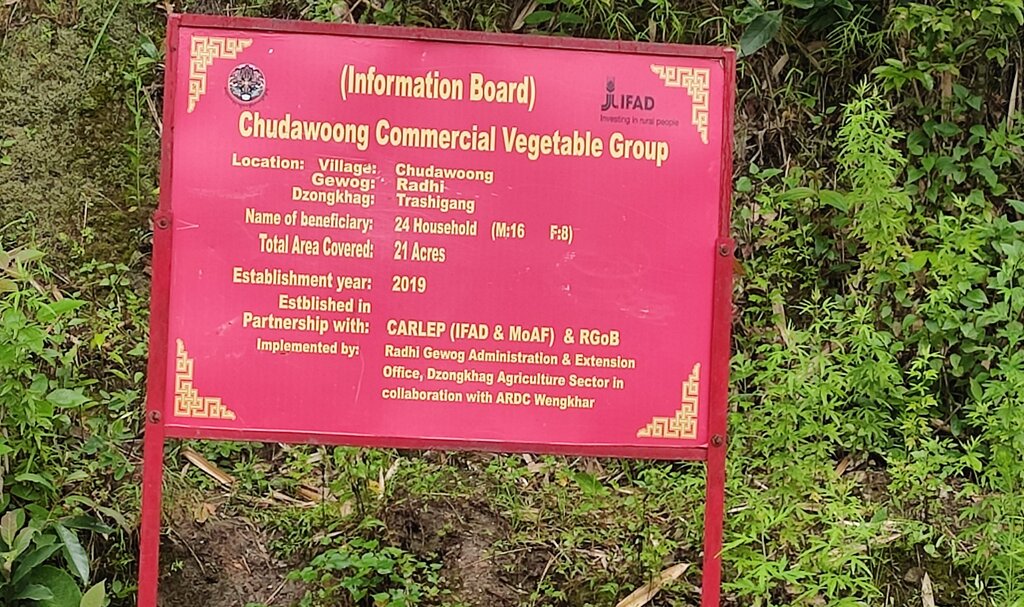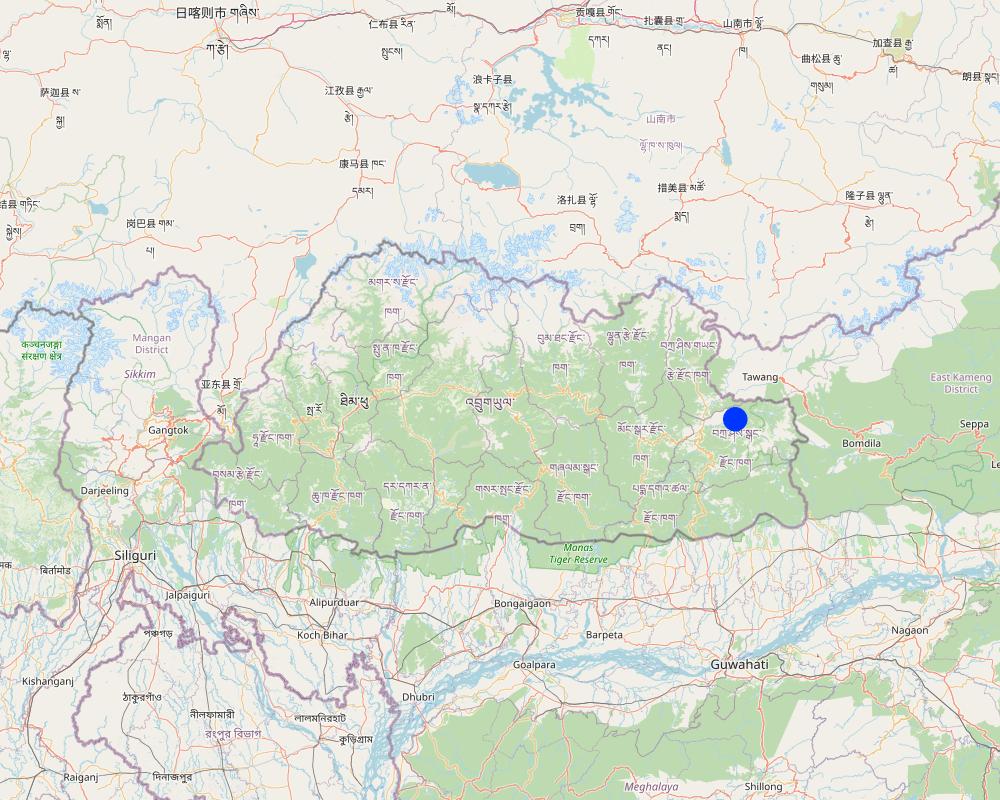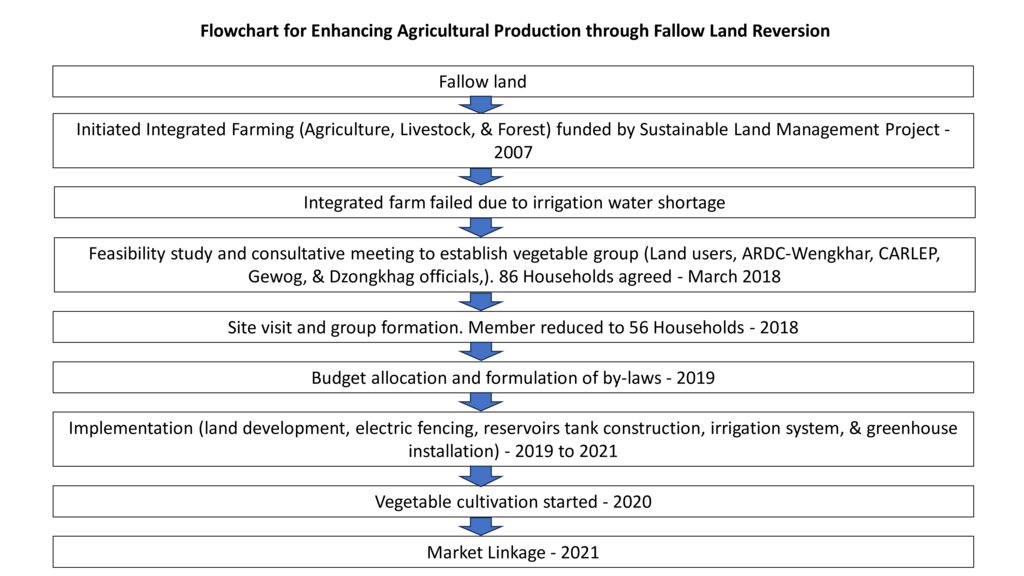Enhancing Agricultural Production Through Fallow Land Reversion [ภูฏาน]
- ผู้สร้างสรรค์:
- การอัพเดท:
- ผู้รวบรวม: Nima Dolma Tamang
- ผู้เรียบเรียง: Tashi Wangdi
- ผู้ตรวจสอบ: William Critchley, Rima Mekdaschi Studer
approaches_6890 - ภูฏาน
ดูส่วนย่อย
ขยายทั้งหมด ย่อทั้งหมด1. ข้อมูลทั่วไป
1.2 รายละเอียดที่ติดต่อได้ของผู้รวบรวมและองค์กรที่เกี่ยวข้องในการประเมินและการจัดเตรียมทำเอกสารของแนวทาง
วิทยากรหลัก
ผู้ใช้ที่ดิน:
Yeshey Kinzang
17675628
Pakaling Chiwog, Radhi Gewog, Trashigang Dzongkhag
ภูฏาน
ผู้ใช้ที่ดิน:
Jamtsho Ten
17642994
Pakaling Chiwog, Radhi Gewog, Trashigang Dzongkhag
ภูฏาน
ผู้ใช้ที่ดิน:
Dendup Pema
77874171
Pakaling Chiwog, Radhi Gewog, Trashigang Dzongkhag
ภูฏาน
ผู้ใช้ที่ดิน:
Pelden Tshering
17558529
Pakaling Chiwog, Radhi Gewog, Trashigang Dzongkhag
ภูฏาน
ผู้ใช้ที่ดิน:
Zangmo Choni
77753201
Pakaling Chiwog, Radhi Gewog, Trashigang Dzongkhag
ภูฏาน
Agriculture Extension Officer:
Wangchen Pema
17436036
pemawangchen2010@gmail.com
Radhi Gewog, Trashigang Dzongkhag
ภูฏาน
ชื่อของโครงการซึ่งอำนวยความสะดวกในการทำเอกสารหรือการประเมินแนวทาง (ถ้าเกี่ยวข้อง)
Strengthening national-level institutional and professional capacities of country Parties towards enhanced UNCCD monitoring and reporting – GEF 7 EA Umbrella II (GEF 7 UNCCD Enabling Activities_Umbrella II)ชื่อของโครงการซึ่งอำนวยความสะดวกในการทำเอกสารหรือการประเมินแนวทาง (ถ้าเกี่ยวข้อง)
National Soil Services Centre, Department of Agriculture, Ministry of Agriculture & Livestock (NSSC) - ภูฏาน1.3 เงื่อนไขที่เกี่ยวข้องกับการใช้ข้อมูลที่ได้บันทึกไว้ผ่านทาง WOCAT
วันที่เก็บรวบรวมข้อมูล (ภาคสนาม):
17/07/2023
ผู้รวบรวมและวิทยากรหลักยอมรับเงื่อนไขเกี่ยวกับการใช้ข้อมูลที่ถูกบันทึกผ่านทาง WOCAT:
ใช่
1.4 การอ้างอิงถึงแบบสอบถามเรื่องเทคโนโลยี SLM
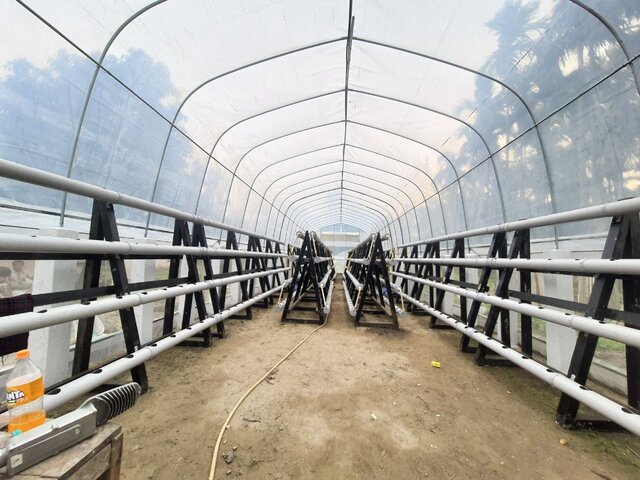
Protected Agriculture for High Value Crops [ภูฏาน]
Protected agriculture (controlled environment agriculture) is the use of technology to modify the growing environment for crops to extend the growing period and increase yields. It can include greenhouses, shade nets or polytunnels. This technology is moderately expensive therefore it is used only for the cultivation of high-value crops and …
- ผู้รวบรวม: Nima Dolma Tamang
2. คำอธิบายของแนวทาง SLM
2.1 การอธิบายแบบสั้น ๆ ของแนวทาง
The approach is to enhance production of local vegetables and fruits through fallow land restoration - under a group established for the purpose.
2.2 การอธิบายอย่างละเอียดของแนวทาง
การอธิบายอย่างละเอียดของแนวทาง:
This approach of reverting fallowed land to productivity encompasses leasing land, working in groups, promoting SLM technologies, and forging market linkages. In this example, the land belongs to the community Lhakang (temple) where the community used to grow maize and pulses to be offered to the Lhakang. However, with increased wild animal depredation, and shortages of irrigation water the land was left fallow. In 2019, with support from the government and the Commercial Agriculture and Resilient Livelihoods Enhancement Program (CARLEP), International Fund for Agriculture Development (IFAD) Project, interested farmers from the community came together, leased the land, and started cultivating vegetables. The reverted fallow land is thus cultivated by the Chuthawoong Commercial Vegetable Farming group which is divided into three subgroups – one of women only - to increase efficiency. The group consist of seven and nine men in two male groups and seven women in one female group. There are no youths involved. The initial development involved the implementation of various SLM technologies such as stone bunding and napier grass strips to reduce soil erosion. Developing market linkages is another characteristic of the approach. The Regional Agricultural Marketing and Cooperatives (RAMCO) linked the land users with three schools to sell vegetables. Furthermore, the group signed a contract with Bhutan Agro Industries Limited (BAIL), Lingmithang (state-owned company) to supply dragon fruit and pineapple for processing.
The main aims and objectives of the approach are to become self-sufficient in vegetables and reduce imports, improve the livelihood and income of the land users and retain youth in agriculture through agricultural mechanization. The methods involved in implementing the approach were consultation among the community leaders and land users, and higher-level consultation with the Gewog Leaders and Dzongkhag Officials, consultation with the Agriculture Research and Development Center (ARDC) Wengkhar and with CARLEP project members.
Stages of implementation included conducting a feasibility study, followed by consultation meetings with the land users. Land development was carried out along with the installation of facilities including fencing, greenhouses, irrigation, and irrigation water storage tanks. After that, the group was formed and bylaws established. Seeds and seedlings were provided by the government.
Stakeholders involved include Gewog officials to develop land lease agreements. The Gewog Extension officer was involved throughout the process in providing guidance and support concerning irrigation, land development, vegetable and fruit cultivation and others. Dzongkhag officials were involved in the feasibility study and planning, and as one of the funding source. CARLEP act as the biggest funding agency to facilitate infrastructure support along with carrying out monitoring activities. ARDC-Wengkhar provided technical support and RAMCO established market linkages.
Land users benefit from increased household income and being self-sufficient in vegetables. The major challenges faced by the land users are distance, as the land is located far away from their houses, and marketing issues, as total production remains above market demand.
2.3 รูปภาพของแนวทาง
2.5 ประเทศ ภูมิภาค หรือสถานที่ตั้งที่ได้นำแนวทางไปใช้
ประเทศ:
ภูฏาน
ภูมิภาค/รัฐ/จังหวัด: :
Trashigang Dzongkhag
ข้อมูลเฉพาะเพิ่มเติมของสถานที่ตั้ง:
Pakaling Chiwog, Radhi Gewog,
Map
×2.6 วันที่เริ่มต้นและสิ้นสุดของแนวทาง
ระบุปีที่เริ่ม:
2017
2.7 ประเภทของแนวทาง
- เป็นนวัตกรรมท้องถิ่นล่าสุด/ นวัตกรรมใหม่
2.8 เป้าหมายหรือวัตถุประสงค์หลักของแนวทาง
The main aim of the approach is to reduce imports by increasing vegetable production, Improve the livelihood and living standard of the land users and retain youth in agriculture through agriculture mechanization.
2.9 เงื่อนไขที่เอื้ออำนวยหรือเป็นอุปสรรคต่อการนำเทคโนโลยีภายใต้แนวทางนี้ไปปฏิบัติใช้
การมีไว้ให้หรือการเข้าถึงแหล่งการเงินและบริการ
- เอื้ออำนวย
The approach received financial support from various organizations. Dzongkhag Administration (Royal Government of Bhutan) provided Nu. 500,000/-, followed by Nu. 850,000/- from CARLEP-IFAD project and Nu. 90,000 from BAIL.
การจัดตั้งระดับองค์กร
- เอื้ออำนวย
There is a very good collaboration between the institutions such as Schools and with the BAIL.
การร่วมมือหรือการทำงานประสานกันของผู้ลงมือปฏิบัติ
- เอื้ออำนวย
Although financial support was provided, the community came together to contribute labour for 300 days per household. The farm is Local Organic Assurance System (LOAS) certified and there is a common understanding to follow the organic guidelines.
กรอบแนวทางในการดำเนินการด้านกฎหมาย (การถือครองที่ดิน สิทธิในการใช้ที่ดินและน้ำ)
- เอื้ออำนวย
The land belongs to the community Lhakang of Pakaling Chiwog. Out of 100 households, only 27 households were interested and engaged in renting the land for crop production. The Local government had facilitated and the lease agreement was drawn between the Lhakhang and community. The land users have to pay a sum of Nu.7500/- to the Lhakang. The group members can cultivate the land for all time while non group members have no right to object or raise any issues. In case, If the group disintegrates in future, any outsider or member of the community can take up the farming activity with no objections from the others.
ความรู้เกี่ยวกับ SLM การเข้าถึงการสนับสนุนด้านเทคนิค
- เอื้ออำนวย
The land users had access to technical support Gewog Extension Officer, the Dzongkhag Agriculture officer and Researchers from the ARDC-Wengkhar.
ตลาด (จัดซื้อปัจจัยนำเข้า ขายผลิตภัณฑ์) และราคา
- เอื้ออำนวย
The groups have a linkage to supply vegetables to the schools and signed the contract with the BAIL, Lingmithang
ปริมาณงานที่ทำได้ กำลังคนที่มีให้
- เป็นอุปสรรค
The land users are engaged in rice cultivation in their own fields and weaving. Therefore, the availability of manpower in the revived land is minimal.
3. การมีส่วนร่วมและบทบาทของผู้มีส่วนได้ส่วนเสียที่เกี่ยวข้อง
3.1 ผู้มีส่วนได้ส่วนเสียที่เกี่ยวข้องในแนวทางนี้และบทบาท
- ผู้ใช้ที่ดินระดับท้องถิ่นหรือชุมชนระดับท้องถิ่น
Land users
Contributed labour during the establishment of the farm and involved in the cultivation of the vegetables. They are the main actors in the approach.
- ผู้เชี่ยวชาญ SLM หรือที่ปรึกษาการเกษตร
Gewog Extension officer, Dzongkhag Agriculture officer, Researchers from ARDC-Wengkhar.
Provides technical support such as training in vegetable cultivation, and setting up irrigation systems.
- ครู เด็กนักเรียน หรือนักศึกษา
Teachers engaged in School Feeding Programme
Purchase farm produce from the group.
- ภาคเอกชน
BAIL
Provides fund support and purchase farm produce for processing
- รัฐบาลระดับท้องถิ่น
Gup, Tshokpa
Involved in developing the land lease agreement.
- รัฐบาลแห่งชาติ (ผู้วางแผน ผู้ทำการตัดสินใจ)
Royal Government of Bhutan
Conduct a feasibility study, and provide financial support.
- องค์การระหว่างประเทศ
CARLEP-IFAD
Provide fund sources for the establishment of the farm and conduct monitoring.
3.2 การเกี่ยวข้องของผู้ใช้ที่ดินระดับท้องถิ่นหรือชุมชนระดับท้องถิ่นในช่วงต่างๆของแนวทาง
| ความเกี่ยวข้องของผู้ใช้ที่ดินระดับท้องถิ่นหรือชุมชนระดับท้องถิ่น | ระบุผู้ที่มีส่วนเกี่ยวข้องและอธิบายกิจกรรม | |
|---|---|---|
| การริเริ่มหรือการจูงใจ | ระดมกำลังด้วยตนเอง | The land was fallow for 27 years and in 2007 the land users tried to restore the land by initiating Integrated Agriculture Farm where they cultivated forest trees, crops and livestock. However, with the unavailability of water, the integrated farm was not successful. People informed the government about the need for a water pump and the Gewog Gup shared it in a higher meeting. This was the initiation of the Land restoration approach. |
| การวางแผน | ปฏิสัมพันธ์ | There were numerous meetings involving the land users, Gewog officials, Gewog Extension Officer, Dzongkhag officials, officials from ARDC-Wengkher and CARLEP. |
| การดำเนินการ | ปฏิสัมพันธ์ | Land users and all the stakeholders were involved in the implementation of the approach. |
| การติดตามตรวจสอบหรือการประเมินผล | ปฏิสัมพันธ์ | External monitoring is done by Audit officers from the stakeholders involved, Audit officers from Bumthang for CARLEP, and Audit officers from Samdrup Jongkhar for RGoB. Internal monitoring is done by the Treasurer of the group. |
3.3 แผนผังแสดงขั้นตอนการทำงาน (ถ้ามี)
คำอธิบาย:
The flowchart has been developed in consultation with the land users and Gewog Agriculture Extension Officer.
ผู้เขียน:
Nima Dolma Tamang
3.4 การตัดสินใจเลือกใช้เทคโนโลยี SLM
ระบุผู้ที่ทำการตัดสินใจเลือกเทคโนโลยีมากกว่าหนึ่งวิธีไปปฏิบัติใช้:
- ผู้ลงมือปฏิบัติที่เกี่ยวข้องทั้งหมดในฐานะที่เป็นส่วนรวมของแนวทาง
การอธิบาย:
All relevant actors were involved in the selection of the technology. Gewog Extension Officer, Dzongkhag Officials, and Researchers from ARDC-Wengkhar provided technical inputs and the land users provided valuable area-specific knowledge based on their experience.
ระบุว่าการตัดสินใจตั้งอยู่บนพื้นฐานของ:
- การประเมินความรู้ SLM ที่ได้ทำการบันทึกไว้เป็นอย่างดี (การใช้ข้อมูลในการตัดสินใจ)
- ประสบการณ์และความคิดเห็นส่วนตัว (ไม่ได้ลงบันทึกไว้)
4. การสนับสนุนด้านเทคนิค การสร้างขีดความสามารถ และการจัดการด้านความรู้
4.1 การสร้างขีดความสามารถ / การอบรม
ได้มีการจัดอบรมให้แก่ผู้ใช้ที่ดินหรือผู้มีส่วนได้ส่วนเสียคนอื่น ๆ หรือไม่:
ใช่
ให้ระบุว่าใครเป็นผู้ได้รับการอบรม:
- ผู้ใช้ที่ดิน
ถ้าเกี่ยวข้อง ให้ระบุ เพศ อายุ สถานภาพ ชาติพันธุ์ เป็นต้น:
The training was provided to 7 women and 16 men.
รูปแบบการอบรม:
- ใช้พื้นที่ทำการสาธิต
- จัดการประชุมสู่สาธารณชน
หัวข้อที่พูด:
Soil nutrient management, vegetable production technique, compost making and others.
4.2 การบริการให้คำแนะนำ
ผู้ใช้ที่ดินมีการเข้าถึงการรับบริการให้คำปรึกษาหรือไม่:
ใช่
ระบุว่ามีบริการให้คำปรึกษาหรือไม่:
- ไปเยี่ยมชมสถานที่
- ที่ศูนย์ถาวร
- On social media (WeChat)
การอธิบาย/แสดงความคิดเห็น:
Advisory service in the form of hands on training at site, at gewog centers and online social media forums such as WeChat.
4.3 การเสริมความแข็งแกร่งให้กับสถาบัน (การพัฒนาองค์กร)
สถาบันได้รับการจัดตั้งขึ้นมาหรือเสริมความแข็งแกร่งโดยแนวทางนี้หรือไม่:
- ใช่ ปานกลาง
ระบุระดับของสถาบันที่ได้รับการเสริมความแข็งแกร่งหรือจัดตั้งขึ้นมา:
- ท้องถิ่น
- ภูมิภาค
อธิบายถึงสถาบัน บทบาทและความรับผิดชอบ สมาชิก เป็นต้น:
The role of the group is to meet their objectives through vegetable production and motivate one another.
ระบุประเภทของการให้ความช่วยเหลือสนับสนุน:
- ด้านการเงิน
- การสร้างขีดความสามารถ / การอบรม
- อุปกรณ์
ให้รายละเอียดเพิ่มเติม :
The land users benefit from the approach as the income generated is useful in sustaining their livelihoods. Land users' capacity was built as they were engaged in the training and implementation of various SLM technologies. The group received equipment such as an irrigation system, electric fencing, greenhouse and others.
4.4 การติดตามตรวจสอบและประเมินผล
การติดตามตรวจสอบและประเมินผลเป็นส่วนหนึ่งของแนวทางหรือไม่:
ใช่
ความคิดเห็น:
The monitoring and evaluation are done by the donors to evaluate the success of the approach. The monitoring includes site visits and verifying the documents on the purchase and sale of the inputs of the produce and its economic benefits to the land users.
ถ้าตอบว่าใช่ แสดงว่าการจัดเตรียมเอกสารนี้มุ่งหวังที่จะเอาไปใช้สำหรับการติดตามตรวจสอบและประเมินผลใช่หรือไม่:
ไม่ใช่
4.5 การวิจัย
การวิจัยเป็นส่วนหนึ่งของแนวทางหรือไม่:
ไม่ใช่
5. การสนับสนุนด้านการเงินและวัสดุอุปกรณ์
5.1 ระบุงบประมาณประจำปีสำหรับแนวทาง SLM นี้
ถ้าหากว่างบประมาณประจำปีไม่เป็นที่ทราบแน่นอน ให้ระบุช่วงลงไป:
- 10,000-100,000
แสดงความคิดเห็น (แหล่งของการระดมทุน ผู้บริจาคคนสำคัญ):
CARLEP project and Royal Government of Bhutan
5.2 การสนับสนุนด้านการเงิน / วัสดุอุปกรณ์ให้แก่ผู้ใช้ที่ดิน
ผู้ใช้ที่ดินได้รับการสนับสนุนด้านการเงิน / วัสดุอุปกรณ์ไปปฏิบัติใช้เทคโนโลยีหรือไม่:
ใช่
ถ้าใช่ ให้ระบุประเภทของการสนับสนุน เงื่อนไขและผู้จัดหามาให้:
Following are the financial support received by the group. 16 numbers of fabricated greenhouses where the land user paid 20% of the amount and 80% was funded by the donor. 100% funding was provided by the donor for the water pump, electric fencing, internal networking of irrigation, cement, grass-cutting machine, seeds and seedlings, water tank and curing shed construction. Labour input was contributed by the land users. The total of Nu. 90,00,000/- (Ninety hundred thousand) was supported for the project.
5.3 เงินสนับสนุนสำหรับปัจจัยนำเข้า (รวมถึงแรงงาน)
- อุปกรณ์
| ระบุปัจจัยนำเข้าที่ได้รับการสนับสนุน | เห็นด้วยระดับไหน | ระบุเงินสนับสนุน |
|---|---|---|
| Water pump, grass cutting machine | ได้รับการช่วยเหลือทางการเงินแบบเต็ม | Water pump and grass cutting machine 100% funded by the doner. |
- การเกษตร
| ระบุปัจจัยนำเข้าที่ได้รับการสนับสนุน | เห็นด้วยระดับไหน | ระบุเงินสนับสนุน |
|---|---|---|
| เมล็ด | ได้รับการช่วยเหลือทางการเงินแบบเต็ม | By RGoB. |
| Land development | ได้รับการช่วยเหลือทางการเงินแบบเต็ม | 100% machine contribution was done by the government with labour contribution from land users. |
- วัสดุสำหรับการก่อสร้าง
| ระบุปัจจัยนำเข้าที่ได้รับการสนับสนุน | เห็นด้วยระดับไหน | ระบุเงินสนับสนุน |
|---|---|---|
| ถนน | ได้รับการช่วยเหลือทางการเงินแบบเต็ม | By government. |
| Greenhouse, electric fencing, internal networking irrigation system, curing shed | ได้รับการช่วยเหลือทางการเงินบางส่วน | For greenhouses, 80% was funded by the doner, 20% by land users. For electric fencing, internal networking irrigation system, cement, pipes, curing shed and water storage tank materials were funded 100% by the doner with labour contribution made by land users |
- โครงสร้างพื้นฐาน
| ระบุปัจจัยนำเข้าที่ได้รับการสนับสนุน | เห็นด้วยระดับไหน | ระบุเงินสนับสนุน |
|---|
ถ้าแรงงานโดยผู้ใช้ที่ดินเป็นปัจจัยนำเข้าที่มีอยู่มากมาย ระบุด้วยว่าเนื่องจาก:
- สมัครใจ
ความคิดเห็น:
Labour and locally available materials were contributed by the land users.
5.4 เครดิต
มีการจัดหาเครดิตมาให้ภายใต้แนวทาง SLM หรือไม่:
ไม่ใช่
5.5 แรงจูงใจหรือเครื่องมืออื่น ๆ
แรงจูงใจหรือเครื่องมืออื่น ๆ ได้ถูกนำไปใช้ส่งเสริมการใช้เทคโนโลยี SLM หรือไม่:
ไม่ใช่
6. การวิเคราะห์ผลกระทบและการสรุป
6.1 ผลกระทบของแนวทาง
ทำให้ผู้ใช้ที่ดินระดับท้องถิ่นมีอำนาจขึ้น ปรับปรุงการเข้าร่วมของผู้มีส่วนได้ส่วนเสียให้ดีขึ้นหรือไม่:
- ไม่ใช่
- ใช่ เล็กน้อย
- ใช่ ปานกลาง
- ใช่ อย่างมาก
The approach improved farm income and their livelihood. It improved stakeholders participation such as schools, Extension officials, and BAIL.
ช่วยในการตัดสินใจโดยดูจากหลักฐาน ได้หรือไม่:
- ไม่ใช่
- ใช่ เล็กน้อย
- ใช่ ปานกลาง
- ใช่ อย่างมาก
The approach enabled land users and the stakeholders involved to make decisions based on the findings. For example, the land users learned that potato cultivation was not profitable due to insect infestation, so they opted for chili cultivation in the next season.
ช่วยให้ผู้ใช้ที่ดินนำเอาเทคโนโลยี SLMไปใช้และบำรุงรักษาสภาพไว้ได้หรือไม่:
- ไม่ใช่
- ใช่ เล็กน้อย
- ใช่ ปานกลาง
- ใช่ อย่างมาก
Land users implemented stone bunding and napier grass plantation to reduce soil erosion which they have maintained very well as it was very efficient in controlling soil erosion. The Napier grass was also sold creating income opportunities.
ปรับปรุงความรู้และความสามารถของผู้ใช้ที่ดินในการดำเนินการ SLM หรือไม่:
- ไม่ใช่
- ใช่ เล็กน้อย
- ใช่ ปานกลาง
- ใช่ อย่างมาก
The land users were involved in the SLM technologies establishment under the supervision of the SLM specialist leading to improved knowledge.
ปรับปรุงความรู้และความสามารถของผู้มีส่วนได้ส่วนเสียคนอื่น ๆ ให้ดีขึ้นหรือไม่:
- ไม่ใช่
- ใช่ เล็กน้อย
- ใช่ ปานกลาง
- ใช่ อย่างมาก
The stakeholders' knowledge was improved greatly as the challenges faced by the land users were forwarded to the stakeholders (SLM specialist/RAMCO). The stakeholders were to address the challenge and in the process, the stakeholder had to develop new techniques and test them on the field which led to improved knowledge of both the parties.
ทำให้ผู้ใช้ที่ดินระดับท้องถิ่นมีอำนาจขึ้น ปรับปรุงการเข้าร่วมของผู้มีส่วนได้ส่วนเสียให้ดีขึ้นหรือไม่:
- ไม่ใช่
- ใช่ เล็กน้อย
- ใช่ ปานกลาง
- ใช่ อย่างมาก
All the stakeholders and land users worked together to achieve a common goal i.e. increased income for land users and use of fallow land for agriculture production, reduce import.
ทำให้กลุ่มด้อยโอกาสมีอำนาจทางสังคมและเศรษฐกิจหรือไม่:
- ไม่ใช่
- ใช่ เล็กน้อย
- ใช่ ปานกลาง
- ใช่ อย่างมาก
If the land users are interested, irrespective of their wealth and status, all the land users in the community are allowed to participate in the approach. Therefore, economically disadvantaged groups involved in farming activity have improved livelihood and increased household income.
ปรับปรุงความทัดเทียมกันด้านเพศและให้อำนาจแก่ผู้หญิงและเด็กผู้หญิงหรือไม่:
- ไม่ใช่
- ใช่ เล็กน้อย
- ใช่ ปานกลาง
- ใช่ อย่างมาก
The approach has two subgroups with heterogenous members (male and female) and one subgroup has only female members encouraging women's participation in decision-making.
ส่งเสริมให้เยาวชนหรือบุตรหลานของผู้ใช้ที่ดินให้เข้าร่วมใน SLM:
- ไม่ใช่
- ใช่ เล็กน้อย
- ใช่ ปานกลาง
- ใช่ อย่างมาก
The approach was initiated to encourage youths to participate in agricultural activities. However, there is no interest shown by the youths. This could be due to low-income generation, poor market access and less or no recreation facility in the approach site.
นำไปสู่ความมั่นคงด้านอาหารหรือปรับปรุงโภชนาการให้ดีขึ้น:
- ไม่ใช่
- ใช่ เล็กน้อย
- ใช่ ปานกลาง
- ใช่ อย่างมาก
The approach enabled land users to be self-sufficient in vegetables during winter and also generate income by selling the produce. Thus, making the community self-sufficient in vegetables and certain fruits.
ปรับปรุงการเข้าถึงตลาดหรือไม่:
- ไม่ใช่
- ใช่ เล็กน้อย
- ใช่ ปานกลาง
- ใช่ อย่างมาก
The approach linked the land users to the market such as schools and processing units (BAIL).
นำไปสู่โอกาสในการจ้างงาน รายได้หรือไม่:
- ไม่ใช่
- ใช่ เล็กน้อย
- ใช่ ปานกลาง
- ใช่ อย่างมาก
The approach improved the income of the land users as they were able to buy school necessities for their children from the income generated by selling vegetables from the approach site.
6.2 แรงจูงใจหลักของผู้ใช้ที่ดินเพื่อที่จะนำ SLM ไปปฏิบัติใช้
- การผลิตที่เพิ่มขึ้น
The additional cultivation in the area improved food self-sufficiency and food security. Therefore, increased production due to improved soil quality is one of the main motivating factors to adopt SLM.
- กำไร (ความสามารถ) อัตราส่วนค่าใช้จ่ายต่อผลประโยชน์ที่เพิ่มขึ้น
The farmers do not have a significant contribution to the establishment of the SLM, major activities were funded by the government. So all the benefits obtained are profits for the land users. Therefore, this is another important motivation for the adoption of the approach.
6.3 ความยั่งยืนของกิจกรรมของแนวทาง
ผู้ใช้ที่ดินสามารถทำให้สิ่งต่างๆ ที่ได้ปฏิบัติใช้โดยแนวทางนี้ยั่งยืนได้หรือไม่ (โดยไม่มีการสนับสนุนจากภายนอก):
- ใช่
ถ้าตอบว่าใช่ ให้อธิบายว่าอย่างไร :
The approach is sustainable. Even though the market for large quantities of produce is not available. There is a market linkage created with local consumers. Further, the land users can link with the relevant stakeholders to export the produce. Moreover, the land users were well trained in vegetable production to sustain without external support.
6.4 จุดแข็งและข้อได้เปรียบของแนวทาง
| จุดแข็ง / ข้อได้เปรียบของแนวทางในทัศนคติของผู้ใช้ที่ดิน |
|---|
| Improved production and increased cultivable land is major strength of the approach. With the fallow land reversion and sufficient irrigation water, the land is is able to produce large amount of crop. |
| The approach contributed to improved household income. By selling the crops grown in the revived area, the land users get additional income to support their livelihood. |
| จุดแข็ง / ข้อได้เปรียบของแนวทางในทัศนคติของผู้รวบรวมหรือวิทยากรหลัก |
|---|
| Improved nutrition to the school children as the quality of organic vegetables supplied by the group is better than the imported produce grown in a conventional system with the use of pesticides especially from India. |
| Reduces import as the group sell their produce to the schools and nearby community. The demand for vegetable is met by domestic production, therefore there are fewer commodities imported. |
6.5 จุดอ่อน / ข้อเสียเปรียบของแนวทางและวิธีในการแก้ไข
| จุดอ่อน / ข้อเสียเปรียบในทัศนคติของผู้ใช้ที่ดิน | สามารถแก้ไขปัญหาได้อย่างไร |
|---|---|
| The land is far from the houses of the land users making it difficult for the land users to give constant management and care. | |
| Radhi is known as the "Rice bowl of eastern Bhutan" and it is also famous for the Bhuray (type of fabric) gho and kira (National dress). Therefore the reverted land is neglected during peak rice production season and labour demanded by the weaving of the Buray gho and kira high. | |
| Due to less market and surplus production. Land users are challenged with marketing of their crops. | Encourage middlemen to purchase their produce and sell it to other parts of the country. |
7. การอ้างอิงและการเชื่อมต่อ
7.1 วิธีการหรือแหล่งข้อมูล
- ไปเยี่ยมชมภาคสนาม การสำรวจพื้นที่ภาคสนาม
There were six informants, five land users and one Gewog Extension Officer.
- การสัมภาษณ์กับผู้ใช้ที่ดิน
five land users
- การสัมภาษณ์ผู้เชี่ยวชาญด้าน SLM หรือผู้ชำนาญ
One, gewog extension officer
7.2 การอ้างอิงถึงสิ่งตีพิมพ์
ชื่อเรื่อง ผู้เขียน ปี ISBN:
Lhamo C. (2021). Agricultural production through fallow land reversion with numerous interventions. CARLEP. Retrieved from https://carlep.gov.bt/agricultural-production-through-fallow-land-reversion-with-numerous-interventions/
ช่องทางในการสืบค้น และราคา:
https://carlep.gov.bt/agricultural-production-through-fallow-land-reversion-with-numerous-interventions/
ลิงก์และโมดูล
ขยายทั้งหมด ย่อทั้งหมดลิงก์

Protected Agriculture for High Value Crops [ภูฏาน]
Protected agriculture (controlled environment agriculture) is the use of technology to modify the growing environment for crops to extend the growing period and increase yields. It can include greenhouses, shade nets or polytunnels. This technology is moderately expensive therefore it is used only for the cultivation of high-value crops and …
- ผู้รวบรวม: Nima Dolma Tamang
โมดูล
ไม่มีโมดูล


